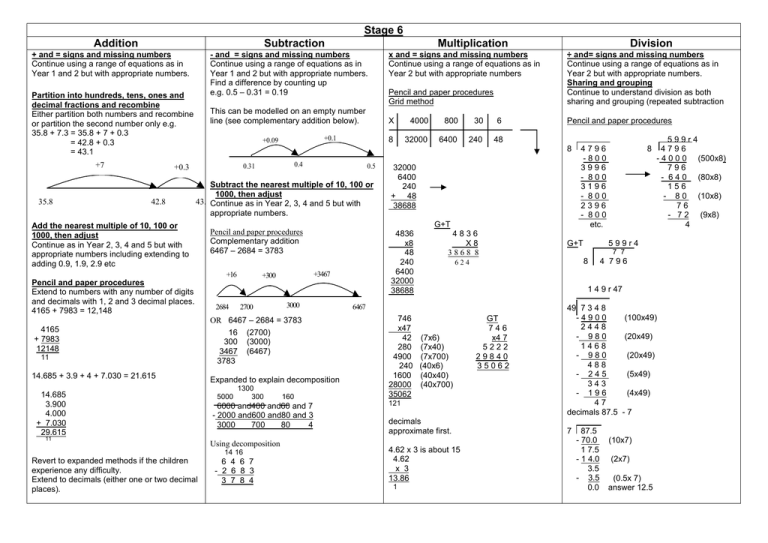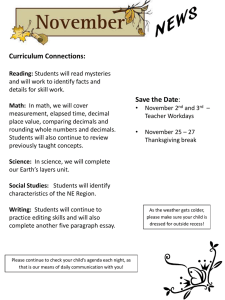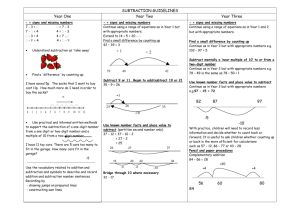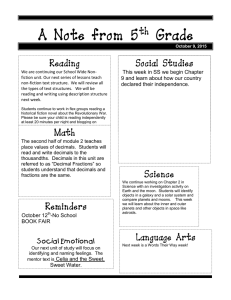Stage 6 Addition Subtraction Multiplication Division
advertisement

Stage 6 Addition Subtraction + and = signs and missing numbers Continue using a range of equations as in Year 1 and 2 but with appropriate numbers. Partition into hundreds, tens, ones and decimal fractions and recombine Either partition both numbers and recombine or partition the second number only e.g. 35.8 + 7.3 = 35.8 + 7 + 0.3 = 42.8 + 0.3 = 43.1 +7 35.8 This can be modelled on an empty number line (see complementary addition below). +0.1 +0.09 x and = signs and missing numbers Continue using a range of equations as in Year 2 but with appropriate numbers Pencil and paper procedures Grid method X 4000 800 30 6 8 32000 6400 240 48 Division ÷ and= signs and missing numbers Continue using a range of equations as in Year 2 but with appropriate numbers. Sharing and grouping Continue to understand division as both sharing and grouping (repeated subtraction Pencil and paper procedures 8 0.4 0.31 +0.3 42.8 Multiplication - and = signs and missing numbers Continue using a range of equations as in Year 1 and 2 but with appropriate numbers. Find a difference by counting up e.g. 0.5 – 0.31 = 0.19 0.5 Subtract the nearest multiple of 10, 100 or 1000, then adjust 43. Continue as in Year 2, 3, 4 and 5 but with appropriate numbers. Add the nearest multiple of 10, 100 or 1000, then adjust Continue as in Year 2, 3, 4 and 5 but with appropriate numbers including extending to adding 0.9, 1.9, 2.9 etc G+T Pencil and paper procedures Complementary addition 6467 – 2684 = 3783 +16 Pencil and paper procedures Extend to numbers with any number of digits and decimals with 1, 2 and 3 decimal places. 4165 + 7983 = 12,148 4165 + 7983 12148 11 14.685 + 3.9 + 4 + 7.030 = 21.615 14.685 3.900 4.000 + 7.030 29.615 11 2684 2700 3000 OR 6467 – 2684 = 3783 16 (2700) 300 (3000) 3467 (6467) 3783 Expanded to explain decomposition 5000 1300 300 160 6000 and400 and60 and 7 - 2000 and600 and80 and 3 3000 700 80 4 Using decomposition 6 4 6 7 - 2 6 8 3 3 7 8 4 4836 x8 48 240 6400 32000 38688 +3467 +300 14 16 Revert to expanded methods if the children experience any difficulty. Extend to decimals (either one or two decimal places). 32000 6400 240 + 48 38688 4836 X8 3868 8 8 599r4 4796 - 4 0 0 0 (500x8) 796 - 6 4 0 (80x8) 156 - 8 0 (10x8) 76 - 7 2 (9x8) 4 599r4 7 7 8 4 796 1 4 9 r 47 (7x6) (7x40) (7x700) (40x6) (40x40) (40x700) 121 decimals approximate first. 4.62 x 3 is about 15 4.62 x 3 13.86 1 G+T 624 6467 746 x47 42 280 4900 240 1600 28000 35062 4796 -800 3996 - 800 3196 - 800 2396 - 800 etc. GT 746 x4 7 5222 29840 35062 49 7 3 4 8 -4900 (100x49) 2448 - 980 (20x49) 1468 - 980 (20x49) 488 - 245 (5x49) 343 - 196 (4x49) 47 decimals 87.5 - 7 7 87.5 - 70.0 1 7.5 - 1 4.0 3.5 - 3.5 0.0 (10x7) (2x7) (0.5x 7) answer 12.5


